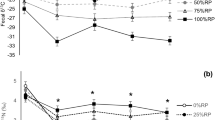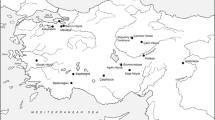Abstract
Faecal stable isotope compositions reflect wildlife diets, if digestive processes along the gastrointestinal tract (GIT) do not alter diet–faeces isotopic relationships in an unpredictable way. We investigated 13C and 15N compositions of digesta along the ruminant GIT, using Saanen dairy goats kept on pure grass hay or browse for >20 days. Isotopic changes occurred in the ventral rumen, and in the small intestine, where digesta had significantly higher δ13C and δ15N (associated with lower C or higher N content, respectively) values relative to other GIT sites. However, effects on isotope fractionation were small (∼1.0‰ for δ13C and ∼ 2.0‰ for δ15N), and were reversed in the hindgut such that faecal isotope compositions did not differ from the foregut. No other substantial isotopic changes occurred across GIT sites, despite the morphophysiological complexity of the ruminant GIT. We found similarly small differences across GIT components of rheem gazelles (Gazella leptoceros) fed a mixture of C3 lucerne and C4 grass, although in this case faeces were 15N-depleted relative to other GIT components. Along with differences in δ15N between goats fed browse or grass, this result implies a systematic difference in diet–faeces δ15N relationships, contingent on the botanical composition of ruminant diets. Thus, while our results support faecal δ13C as a reliable proxy for wildlife diets, further work on factors influencing faecal 15N abundance is needed. Finally, we note high levels of isotopic variability between individuals fed the same diets, even accounting for the relatively short duration of the experiments, suggesting an important influence of stochasticity on isotope fractionation.




Similar content being viewed by others
References
Ambrose SH, Norr L (1993) Experimental evidence for the relationship of the carbon isotope ratios of whole diet and dietary protein to those of bone collagen and carbonate. In: Lambert JB, Grupe G (eds) Prehistoric human bone: archaeology at the molecular level. Springer-Verlag, Berlin, pp 1–37
Ash RW (1968) Flow of digesta in the intestine of the ruminant. In: Phillipson AT (ed) Digestion in the abomasum and intestine of the ruminant. Two hundred and sixth scientific meeting of agricultural sciences. University of Leeds, Leeds
Bearhop S, Waldron S, Votier SC, Furness RW (2002) Factors that influence assimilation rates and fractionation of nitrogen and carbon stable isotopes in avian blood and feathers. Physiol Biochem Zool 75:451–458
Becker-Birck M (2009) Computertomographische Untersuchung des Thorax bei 30 Ziegen. Doctoral dissertation, University of Zürich, Zürich
Boyne AW, Campbell RM, Davidson J, Cuthbertson DP (1956) Changes in composition of the digesta along the alimentary tract of sheep. Br J Nutr 10:325–333
Caut S, Angulo E, Courchamp F (2008) Caution on isotopic model use for analyses of consumer diet. Can J Zool 86:438–445
Cerling TE, Harris JM (1999) Carbon isotope fractionation between diet and bioapatite in ungulate mammals and implications for ecological and paleoecological studies. Oecologia 120:347–363
Cerling TE, Wittemyer G, Ehleringer JR, Remien CH, Douglas-Hamilton I (2009) History of animals using isotope records (HAIR): a 6-year dietary history of one family of African elephants. Proc Natl Acad Sci 106:8093–8100
Clauss M, Fritz J, Bayer D, Hummel J, Streich WJ, Südekum K-H, Hatt JM (2009a) Physical characteristics of rumen contents in two small ruminants of different feeding type, the mouflon (Ovis ammon musimon) and the roe deer (Capreolus capreolus). Zoology 112:195–205
Clauss M, Fritz J, Bayer D, Nygren K, Hammer S, Hatt JM, Südekum K-H, Hummel J (2009b) Physical characteristics of rumen contents in four large ruminants of different feeding type, the addax (Addax nasomaculatus), bison (Bison bison), red deer (Cervus elaphus) and moose (Alces alces). Comp Biochem Physiol A 152:398–406
Clauss M, Lechner I, Barboza P, Collins W, Tervoort TA, Südekum K-H, Codron D, Hummel J (2011) The effect of size and density on the mean retention time of particles in the reticulorumen of cattle (Bos primigenius f. taurus), muskoxen (Ovibos moschatus) and moose (Alces alces). Br J Nutr 105:634–644
Codron D, Clauss M (2010) Rumen physiology constrains diet niche: linking digestive physiology and food selection across wild ruminant species. Can J Zool 88:1129–1138
Codron D, Codron J (2009) Reliability of d13C and d15N in faeces for reconstructing savanna herbivore diet. Mamm Biol 74:36–48
Codron D, Lee-Thorp JA, Sponheimer M, Codron J (2007) Stable carbon isotope reconstruction of ungulate diet changes through the seasonal cycle. S Afr J Wildl Res 37:117–125
Codron D, Codron J, Sponheimer M, Bernasconi SM, Clauss M (2011) When animals are not quite what they eat: diet digestibility influences 13C-incorporation rates and apparent discrimination in a mixed-feeding herbivore. Can J Zool 89:453–465
Crawford K, McDonald RA, Bearhop S (2008) Applications of stable isotope techniques to the ecology of mammals. Mamm Rev 38:87–107
Hobson KA (1999) Tracing origins and migration of wildlife using stable isotopes: a review. Oecologia 120:314–326
Hofmann RR (1973) The ruminant stomach. East African Literature Bureau, Nairobi
Hofmann RR (1989) Evolutionary steps of ecophysiological adaptation and diversification of ruminants: a comparative view of their digestive system. Oecologia 78:443–457
Hummel J, Südekum K-H, Streich WJ, Clauss M (2006) Forage fermentation patterns and their implications for herbivore ingesta retention times. Funct Ecol 20:989–1002
Hummel J, Südekum K-H, Bayer D, Ortmann S, Hatt JM, Streich WJ, Clauss M (2009) Physical characteristics of reticuloruminal contents of cattle in relation to forage type and time after feeding. J Anim Physiol Anim Nutr 93:209–220
Hwang YT, Millar JS, Longstaffe FJ (2007) Do d15N and d13C values of feces reflect the isotopic composition of diets in small mammals? Can J Zool 85:388–396
Irmer M (2010) Computed tomography of the abdomen in 30 goats. Doctoral thesis, University of Zürich, Zürich
Jones RJ, Ludlow MM, Troughton JH, Blunt CG (1981) Changes in the natural carbon isotope ratios of the hair from steers fed diets of C4, C3 and C4 species in sequence. Search 12:85–87
Layman CA, Arrington DA, Montańa CG, Post DM (2007) Can stable isotope ratios provide for community-wide measures of trophic structure? Ecology 88:42–48
Lechner I, Barboza P, Collins W, Fritz J, Günther D, Hattendorf B, Hummel J, Südekum K-H, Clauss M (2010) Differential passage of fluids and different-sized particles in fistulated oxen (Bos primigenius f. taurus), muskoxen (Ovibos moschatus), reindeer (Rangifer tarandus) and moose (Alces alces): rumen particle size discrimination is independent from contents stratification. Comp Biochem Physiol A 155:211–222
Martínez del Rio C, Anderson-Sprecher R (2008) Beyond the reaction progress variable: the meaning and significance of isotopic incorporation data. Oecologia 156:765–772
Martínez del Rio C, Wolf N, Carleton SA, Gannes LZ (2009) Isotopic ecology ten years after a call for more laboratory experiments. Biol Rev 84:91–111
Newsome SD, Martinez del Rio C, Bearhop S, Phillips DL (2007) A niche for isotopic ecology. Front Ecol Environ 5:429–436
Newsome SD, Bentall GB, Tinker MT, Oftedal OT, Ralls K, Estes JA, Fogel ML (2010) Variation in d13C and d15N diet–vibrissae trophic discrimination factors in a wild population of California sea otters. Ecol Appl 20:1744–1752
Norman HC, Wilmot MG, Thomas DT, Masters DG, Revell DK (2009) Stable carbon isotopes accurately predict diet selection by sheep fed mixtures of C3 annual pastures and saltbush or C4 perennial grasses. Livest Sci 121:162–172
Passey BH, Robinson TF, Ayliffe LK, Cerling TE, Sponheimer M, Dearing MD, Roeder BL, Ehleringer JR (2005) Carbon isotope fractionation between diet, breath CO2, and bioapatite in different animals. J Archaeol Sci 32:1459–1470
Phillips D, Newsome S, Gregg J (2005) Combining sources in stable isotope mixing models: alternative methods. Oecologia 144:520–527
Sponheimer M, Robinson T, Ayliffe L, Passey B, Roeder B, Shipley L, Lopez E, Cerling T, Dearing D, Ehleringer J (2003) An experimental study of carbon-isotope fractionation between diet, hair, and feces of mammalian herbivores. Can J Zool 81:871–876
Sponheimer M, Codron D, Passey BH, Lee-Thorp JA, De Ruiter D, Cerling TE (2009) Using carbon isotopes to track dietary change in modern, historical, and ancient primates: a look at the methods and a discussion of fallback foods in australopith diets. Am J Phys Anthropol 140:661–670
Statsoft_Inc (2007) STATISTICA Version 8.0 (data analysis software system). www.statsoft.com. Statsoft, Inc., Tulsa, Oklahoma
Steele KW, Daniel RMJ (1978) Fractionation of nitrogen isotopes by animals: a further complication to the use of variations in the natural abundance of 15N for tracer studies. J Agric Sci 90:7–9
Stevens CE, Hume ID (1995) Comparative physiology of the vertebrate digestive system. Cambridge University Press, New York
Sutoh M, Koyama T, Yoneyama T (1987) Variations of natural 15N abundances in the tissues and digesta of domestic animals. Radioisotopes 36:74–77
Tieszen LL, Boutton TW, Tesdahl KG, Slade NA (1983) Fractionation and turnover of stable carbon isotopes in animal tissues: implications for δ13C analysis of diet. Oecologia 57:32–37
Treydte AC, Bernasconi SM, Kreuzer M, Edwards PJ (2006) Diet of the common warthog (Phacochoerus africanus) on former cattle grounds in a Tanzanian savanna. J Mammal 87:889–898
Vander Zanden HB, Bjorndal KA, Reich KJ, Bolten AB (2010) Individual specialists in a generalist population: results from a long-term stable isotope series. Biol Lett 6:711–714. doi:10.1098/rsbl.2010.0124
Voigt CC, Baier L, Speakman JR, Siemers BM (2008) Stable carbon isotopes in exhaled breath as tracers for dietary information in birds and mammals. J Exp Biol 211:2233–2238
Wattiaux MA, Reed JD (1995) Fractionation of nitrogen isotopes by mixed ruminal bacteria. J Anim Sci 73:257–266
Wittmer MHOM, Auerswald K, Schönbach P, Schäufele R, Müller K, Yang H, Bai YF, Susenbeth A, Taube F, Schnyder H (2010) Do grazer hair and faeces reflect the carbon isotope composition of semi-arid C3/C4 grassland? Basic Appl Ecol 11:83–92
Acknowledgements
We thank Merle Gierga, Stewart Bishop, Werner Suter, and Carla Soliva for laboratory assistance, and Catrin Hammer and Muthukrishnan Chelapandythevar for help with experimental animals. We thank Jeanne Peter for the diagram used in Fig. 1. Three anonymous reviewers commented on an earlier version, leading to significant improvements. Funding was provided by the European Union (Marie-Curie PIIF-GA-2009-236670) and the Swiss National Fund (IZ32Z0-125787). The study was approved by the ethics committee of the canton of Zürich, Switzerland.
Author information
Authors and Affiliations
Corresponding author
Additional information
Communicated by C. Gortázar
Rights and permissions
About this article
Cite this article
Codron, D., Sponheimer, M., Codron, J. et al. Tracking the fate of digesta 13C and 15N compositions along the ruminant gastrointestinal tract: Does digestion influence the relationship between diet and faeces?. Eur J Wildl Res 58, 303–313 (2012). https://doi.org/10.1007/s10344-011-0581-3
Received:
Revised:
Accepted:
Published:
Issue Date:
DOI: https://doi.org/10.1007/s10344-011-0581-3




